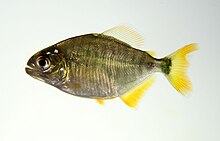Pygopristis denticulata
| Pygopristis denticulata | |
|---|---|

| |
| Scientific classification | |
| Kingdom: | |
| Phylum: | |
| Class: | |
| Order: | |
| Family: | |
| Tribe: | |
| Genus: | Pygopristis J. P. Müller & Troschel, 1844
|
| Species: | P. denticulata
|
| Binomial name | |
| Pygopristis denticulata (G. Cuvier, 1819)
| |
| Synonyms | |
| |
Pygopristis denticulata is a species of piranha. These fish are part of the group Ostariophysi, a large group of freshwater fish that includes minnows and catfishes.[1] It is a rare South American fish found in the Orinoco River basin, north and eastern Guiana Shield rivers, and tributaries of the lower Amazon River.[2] Piranhas typically live in freshwater,[3] but other specimens can be found elsewhere. Specimens of this species is frequently found in acidic clear or black waters. Piranhas are primarily known for being savage, flesh-eating fish, but they actually have broader diets.[4] They usually feed on aquatic insects, small fish, and fruits.[5]
P. denticulata has pentacuspid teeth and a middle cusp that is usually only slightly larger than the other cusps. This is unlike the piranhas, which have tricuspid teeth with a larger middle cusp, making the teeth appear triangular.[6]
P. denticulata grows to about 20.0 cm (7.9 in) in TL.[2] It has 62 chromosomes.[6] This fish possesses powerful dentition that can cause serious bites. It has scales.[2]
References[]
- ^ Fink, William L. (1989-01-01). "Ontogeny and phylogeny of shape and diet in the South American fishes called piranhas". Geobios. Ontogenèse Et Évolution. 22: 167–172. doi:10.1016/S0016-6995(89)80017-8. ISSN 0016-6995.
- ^ a b c Froese, Rainer; Pauly, Daniel (eds.) (2007). "Pygopristis denticulata" in FishBase. July 2007 version.
- ^ Fink, William L. (1989-01-01). "Ontogeny and phylogeny of shape and diet in the South American fishes called piranhas". Geobios. Ontogenèse Et Évolution. 22: 167–172. doi:10.1016/S0016-6995(89)80017-8. ISSN 0016-6995.
- ^ Fink, William L. (1989-01-01). "Ontogeny and phylogeny of shape and diet in the South American fishes called piranhas". Geobios. Ontogenèse Et Évolution. 22: 167–172. doi:10.1016/S0016-6995(89)80017-8. ISSN 0016-6995.
- ^ Machado-Allison, A. and W. Fink (1996). Los Peces Caribes de Venezuela. Diagnosis, claves, aspectos ecológicos y evolutivos. Universidad Central de Venezuela, CDCV. (Colección Monografías), Caracas, ISBN 980-00-0967-1, 149p.
- ^ a b Freeman, Barbie; Nico, Leo G.; Osentoski, Matthew; Jelks, Howard L.; Collins, Timothy M. (2007). "Molecular systematics of Serrasalmidae: Deciphering the identities of piranha species and unraveling their evolutionary histories" (PDF). Zootaxa. 1484: 1–38. doi:10.1046/j.1439-0469.2000.384132.x.
- Serrasalmidae
- Piranhas
- Monotypic fish genera
- Fish of Brazil
- Fish described in 1819
- Taxa named by Georges Cuvier
- Characiformes stubs